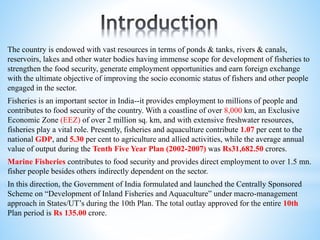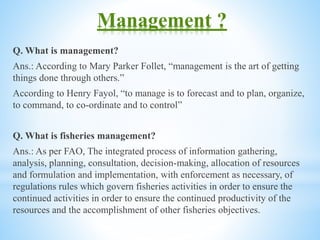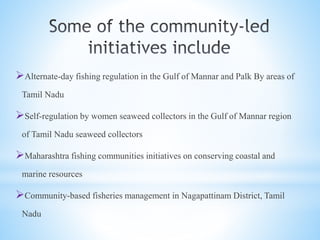Indian fisheries management
- 1. Indian Fisheries Management Krishna M. Jha 37th Batch SIF, CUSAT Roll No. - 11
- 2. The country is endowed with vast resources in terms of ponds & tanks, rivers & canals, reservoirs, lakes and other water bodies having immense scope for development of fisheries to strengthen the food security, generate employment opportunities and earn foreign exchange with the ultimate objective of improving the socio economic status of fishers and other people engaged in the sector. Fisheries is an important sector in India--it provides employment to millions of people and contributes to food security of the country. With a coastline of over 8,000 km, an Exclusive Economic Zone (EEZ) of over 2 million sq. km, and with extensive freshwater resources, fisheries play a vital role. Presently, fisheries and aquaculture contribute 1.07 per cent to the national GDP, and 5.30 per cent to agriculture and allied activities, while the average annual value of output during the Tenth Five Year Plan (2002-2007) was Rs31,682.50 crores. Marine Fisheries contributes to food security and provides direct employment to over 1.5 mn. fisher people besides others indirectly dependent on the sector. In this direction, the Government of India formulated and launched the Centrally Sponsored Scheme on “Development of Inland Fisheries and Aquaculture” under macro-management approach in States/UT’s during the 10th Plan. The total outlay approved for the entire 10th Plan period is Rs 135.00 crore.
- 3. Indian Fisheries at a Glance According to the CMFRI Census 2010, there are 3,288 marine fishing villages and 1,511 marine fish landing centers in 9 maritime states and 2 union territories. The total marine fisher folk population was about 4 million comprising in 864,550 families. Nearly 61% of the fishermen families were under BPL category. The average family size was 4.63 and the overall sex ratio was 928 females per 1000 males. Almost 58% of the fisher folk were educated with different levels of education. About 38% marine fisher folk were engaged in active fishing with 85% of them having full time engagement. About 63.6% of the fisher folk were engaged in fishing and allied activities. Nearly 57% of the fisher folk engaged in fish seed collection were females and 43% were males. Among the marine fishermen households nearly 76% were Hindus, 15% were Christians and 9% were Muslims. The overall percentage of SC/ST among the marine fishermen households was17%. The Indian coastline can be delineated into 22 zones, based on the ecosystem structure and functions. The Indian boat type ranges from the traditional catamarans, masula boats, plank-built boats, dug out canoes, machwas, dhonis to the present day motorized fiber-glass boats, mechanized trawlers and gillnetters. In the marine fisheries sector, there were 194,490 crafts in the fishery out of which 37% were mechanized, 37% were motorized and 26% were non-motorized. Out of a total of 167,957 crafts fully owned by fisher folk 53% were non-motorized, 24% were motorized and 23% were mechanized. Among the mechanized crafts fully owned by fishermen, 29% were trawlers, 43% were gillnetters and 19% were dolnetters. India's marine capture fish production ,increased from 520,000 tonnes in 1950 to 3.15 million tonnes in 2007. The bulk of the catch comprises oil sardines, followed by penaeid and non-penaeid shrimp, Indian mackerel, Bombay duck, croakers, smaller quantities of cephalopods, other sardines and threadfin breams.(CMFRI 2008).
- 4. Inland Fisheries India’s freshwater resources consists of rivers and canals (197,024 km), reservoirs (3.15 million ha), ponds and tanks (235 million ha), oxbow lakes and derelict waters (1.3 million ha), brackishwaters (1.24 million ha) and estuaries (0.29 million ha). The inland capture fish production has increased from 192,000 tonnes in 1950 to 781,846 tonnes in 2007, the major species being cyprinids, siluroids and murrels.
- 6. Management ? Q. What is management? Ans.: According to Mary Parker Follet, “management is the art of getting things done through others.” According to Henry Fayol, “to manage is to forecast and to plan, organize, to command, to co-ordinate and to control” Q. What is fisheries management? Ans.: As per FAO, The integrated process of information gathering, analysis, planning, consultation, decision-making, allocation of resources and formulation and implementation, with enforcement as necessary, of regulations rules which govern fisheries activities in order to ensure the continued activities in order to ensure the continued productivity of the resources and the accomplishment of other fisheries objectives.
- 7. Overview Fisheries management in India, can be categorized into management of fisheries in the EEZ and in the territorial waters. According to the Constitution of India, the Central (Federal) government has jurisdiction over the fisheries in the EEZ, while the State (Provincial) governments have jurisdiction over fisheries in the territorial waters.
- 8. Fisheries Management in the EEZ Some of the important central legal frameworks for fisheries management are: Comprehensive Marine Fishing Policy, 2004. Guidelines for fishing operations in Indian EEZ. Letter of intent for operation of fishing vessels NFF comment on the Draft Marine fishing regulation and management bill, 2009.
- 9. Objectives The main objective of the policy is to ensure sustainable development of marine fisheries with due concern for ecological integrity and biodiversity. The policy calls for adopting fisheries management regimes such as - registration of fishing vessels, observation of closed fishing seasons, proscription of destructive fishing methods, implementation of mesh size regulations, reduction of by catch and discards and establishing an effective monitoring, control and surveillance mechanism. The guidelines specifically calls for compliance with CCRF and other international rules and regulations in the management of fish stocks. Besides these, a uniform fishing holiday is declared every year in the EEZ along east and west coasts. A national committee has also been constituted to effectively implement the provisions of the 1995 CCRF.
- 11. Five-Year Plan From the very beginning of the plan era, the State has made efforts for planned development to fulfill the aspiration of its people. During First Five-year Plan, agricultural production, irrigation, power and basic social services i.e. education, medical facilities, and drinking water were the main focus areas. Agriculture, Irrigation, Power and Social services continued to receive attention during Second Five-year Plan. Rajasthan became a pioneering state in introducing 3 tier Panchayati Raj System from 2nd October 1959.
- 12. Five Years Plan on Fisheries Fisheries development and planning is undertaken through the Five- Year Plans formulated by the government since 1951. The initial Five- Year Plans, starting from the 1950s, focused more on the ‘development’ of the sector, and on increasing production, while it was only in the Ninth and Tenth Five-Year Plan period that the need for conservation and management was explicitly recognized.
- 13. Developmental Management Several conservation measures have been initiated by the Ministry of Environment and Forests (MoEF), especially towards safeguarding against trade in endangered species (such as sea turtle, sea cucumbers, sea horse, and several species of molluscs), protection of certain habitats such as coral reefs, mangroves and breeding grounds of turtles, by designating protected areas (such as national parks and sanctuaries).
- 14. Plan Period Approved Outlay (Rs. In Cr.) Actual Exp. (Rs. In Cr.) I Plan 1951-56 64.5 54.15 II Plan 1956-61 105.27 102.74 III Plan 1961-66 236 212.7 Annual Plan 1966-67 48.87 48.9 Annual Plan 1967-68 43.65 39.88 Annual Plan 1968-69 40.08 47.98 IV Plan 1969-74 306.21 308.79 V Plan 1974-79 847.16 857.62 Annual Plan 1979-80 275 290.19 VI Plan 1980-85 2025 2120.45 VII Plan 1985-90 3000 3106.18 Annual Plan 1990-91 956 975.57 Annual Plan 1991-92 1170 1184.41 VIII Plan 1992-97 11500 11998.97 IX Plan 1997-2002 27650 19566.82
- 15. Important Physical Achievements during Tenth Plan Scheme Ind./Cum Unit 2002- 03 2003-04 2004-05 2005-06 2006-07 (Likely) Fisheries a. Fish seed production Ind. Million No. Fry 185 303.01 255.17 299.34 300 b. Fish production Ind. 000 Tones 13.4 14.3 16.39 18.47 20
- 16. State level fisheries management Institutional Management Community-led initiatives
- 17. Fisheries management is undertaken mainly through licensing, prohibitions on certain fishing gear, regulations on mesh size and establishment of closed seasons and areas, under the Marine Fishing Regulation Act (MFRA). Zones are demarcated by each State based on distance from the shoreline (from 5 km to 10 km) or on depth. These inshore zones, where trawling and other forms of mechanized fishing is not permitted, are perhaps the most important space-based fisheries management measure in place. The closed season or ‘monsoon fishing ban’ is another important ‘temporo-spatial’ management measure implemented on both the east and west coasts of India for a period of 47 days and 65 days respectively, during, what is considered to be the spawning and breeding season. Besides these, there are several State-specific management measures, such as fishing regulation measures adopted by Orissa to protect the turtle nesting and breeding grounds, mandatory requirement to use turtle excluder devices.
- 18. Institutional Management The responsibility for fisheries and marine habitat is spread across several agencies and Ministries at the Central level. Department of Animal Husbandry, Dairying and Fisheries, Ministry of Agriculture National Fisheries Development Board, Ministry of Agriculture Coast Guard, Ministry of Defense Ministry of Environment and Forests Earth Commission, Ministry of Earth Sciences Planning commission of India Fish Farmers Development Authority Marine Products Export Development Authority
- 19. Community-led initiatives Community-level institutions also play an important role in fisheries governance along the coast. Examples that have been documented include the Kadakodi system of northern Kerala, Pedhaloo in southern Orissa, and the federated structure of the traditional Panchayat system of the Pattanavars community of Tamil Nadu/Andhra Pradesh coast (Vivekanandan 2009, Koshy 2007). These traditional governance systems, while important, are not officially recognized and/or involved in resources management. However, a recent FAO United Nations Team for Tsunami Recovery Support (UNTRS) project titled “Towards Developing a New Co-Management Regime in India”, along with the South Indian Federation of Fishermen Societies (SIFFS), noted the potential of traditional Panchayat structure of the Pattanavars along the Coromandel Coast in fisheries management (FAO 2008). Through the project, resource management councils were formed with representatives from traditional Panchayats from different villages and Fisheries Department officials of Tamil Nadu government, to explore options for community based co-management arrangements at the local level. For more information: FAO/UNTRS. 2008. Setting directions for sustainable fisheries and coastal livelihoods in the post tsunami context, India: A report of the interventions by the FAO under the United Nations team for Tsunami Recovery Support. FAO, UNTRS and UNDP. New Delhi.
- 20. Alternate-day fishing regulation in the Gulf of Mannar and Palk By areas of Tamil Nadu Self-regulation by women seaweed collectors in the Gulf of Mannar region of Tamil Nadu seaweed collectors Maharashtra fishing communities initiatives on conserving coastal and marine resources Community-based fisheries management in Nagapattinam District, Tamil Nadu
- 21. Schemes o Centrally sponsored scheme on "Development of Inland Fisheries and Aquaculture" o Centrally sponsored scheme on "Development of Marine Fisheries, Infrastructure and Post Harvest Operation" o Centrally sponsored scheme on "Welfare of Fishermen" o Schemes of NCDC in the Development of Fisheries o On-going subsidy schemes of MPEDA
- 22. Development of Inland Fisheries and Aquaculture 1. Development of Freshwater Aquaculture. 2. Development of Brackishwater Aquaculture. 3. Coldwater Fisheries and Aquaculture. 4. Development of Waterlogged Areas. 5. Productive Utilization of Inland Saline/Alkaline Soils for Aquaculture. 6. Integrated Development of Inland Capture Resources (reservoirs/rivers etc.)
- 23. Strategies The expenditure on developmental activities will be shared on 75:25 basis by the Government of India and the State/UT Governments in respect of all aforesaid components. The two components namely, Development of Freshwater Aquaculture and Brackishwater Aquaculture are to be implemented by a single agency (FFDA). The remaining four components are to be implemented through the Fisheries Department of the respective States/UT’s. Besides subsidy on the approved items under the scheme, the balance amount for these items may be obtained as loan made available to the beneficiaries through FFDA’s/States/UT’s Fisheries Department from lead banks/participating banks. Subsidy for all approved items under the scheme can also be given to a beneficiary if the remaining cost of items is contributed by him from his/her own resources and is duly certified by the FFDA’s/States/UT’s Fisheries Department.
- 24. Programmes The implementing agencies had to furnish quarterly/annual progress reports indicating physical and financial achievements regularly in the prescribed format already communicated to the State/UT Government. The accounts of the agency shall be subject to audit by Chartered Accountants appointed by the agency and/or by such other officers of Government of India/State/UT Governments as required under the rules and report should be intimated to this Ministry. The State/UT Governments has to ensure that the proposals for the various components are complete in all aspects accompanied by detailed progress reports of the central share released during the proceeding years and reasons for shortfalls, if any, etc. The availability of budgetary provision in the State Budget should be specifically indicated in the proposal.
- 25. Achievement In 1977 the level of availability of fish for the entire population of the country was only 4.13 kg per capita per annum, as compared to 14.9 kg in the United States of America and 10.9 kg for the United Kingdom. During 1950 to 1977 he national income from fisheries, as assessed by the Central Statistical Organisation is of the order of Rs. 3,610 million out of the total national income from Agriculture estimated at Rs. 2,74,760 million. During 1950 - 1977 achievements registered in the fish production from a level of 0.75 million tonnes to 2.3 million tonnes and the export earning through marine products from Rs. 25.6 million to Rs. 2,000 million during the last 25 years, is highly significant. However, when compared to the vast resources potential, it should be possible to raise substantially the level of production and export earnings. The National Commission on Agriculture has estimated that the fish production of the country could be stepped up to 8 million tonnes in the next twenty five years.
- 26. 1. Per capita fish consumption grown to 9.8 kg (FAO) 2. India’s seafood export have touched all time high of Rs. 18,856 crore for 2012-13 (MPEDA 2012-13) 3. India’s total export value is $ 3,512 million (MPEDA 2012-13) 4. The total quantity of exports showed a rise of 7.68% to 9,28,215 tonnes (MPEDA 2012-13) 5. The total marine fish landing 3.94 million metric tonnes (CMFRI Annual report 2012-13) 6. Landing centers – 151 7. Major fishing harbors – 6 8. Minor fishing harbors – 38 9. Mechanized fishing vessel – 72,559 10.Motorized fishing vessel – 71,313 11. Non motorized fishing vessel – 50,618 (Source: Fishing Chimes, Vol.- 33, Page No.- 58)
- 27. Thank You ….. Any ‘ ? ’ Plz….



























